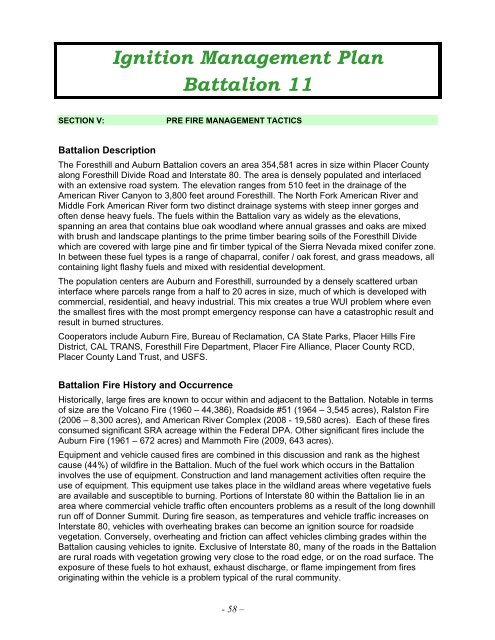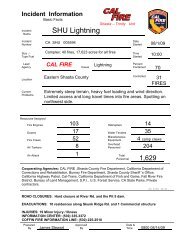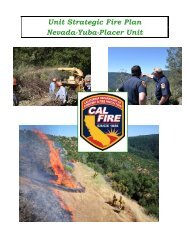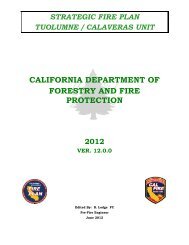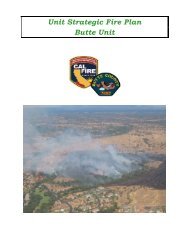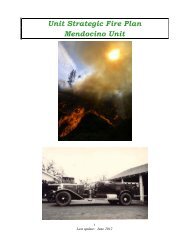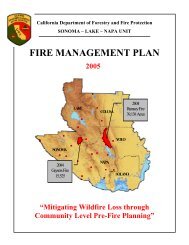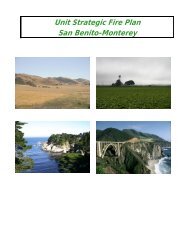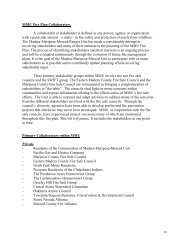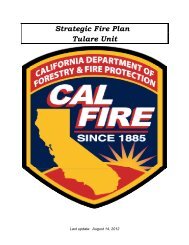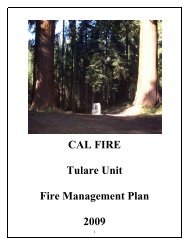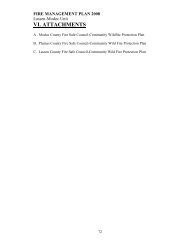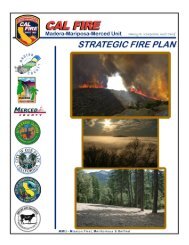Nevada-Yuba-Placer Strategic Fire Plan 2011 - Board of Forestry ...
Nevada-Yuba-Placer Strategic Fire Plan 2011 - Board of Forestry ...
Nevada-Yuba-Placer Strategic Fire Plan 2011 - Board of Forestry ...
Create successful ePaper yourself
Turn your PDF publications into a flip-book with our unique Google optimized e-Paper software.
Ignition Management <strong>Plan</strong><br />
Battalion 11<br />
SECTION V: PRE FIRE MANAGEMENT TACTICS<br />
Battalion Description<br />
The Foresthill and Auburn Battalion covers an area 354,581 acres in size within <strong>Placer</strong> County<br />
along Foresthill Divide Road and Interstate 80. The area is densely populated and interlaced<br />
with an extensive road system. The elevation ranges from 510 feet in the drainage <strong>of</strong> the<br />
American River Canyon to 3,800 feet around Foresthill. The North Fork American River and<br />
Middle Fork American River form two distinct drainage systems with steep inner gorges and<br />
<strong>of</strong>ten dense heavy fuels. The fuels within the Battalion vary as widely as the elevations,<br />
spanning an area that contains blue oak woodland where annual grasses and oaks are mixed<br />
with brush and landscape plantings to the prime timber bearing soils <strong>of</strong> the Foresthill Divide<br />
which are covered with large pine and fir timber typical <strong>of</strong> the Sierra <strong>Nevada</strong> mixed conifer zone.<br />
In between these fuel types is a range <strong>of</strong> chaparral, conifer / oak forest, and grass meadows, all<br />
containing light flashy fuels and mixed with residential development.<br />
The population centers are Auburn and Foresthill, surrounded by a densely scattered urban<br />
interface where parcels range from a half to 20 acres in size, much <strong>of</strong> which is developed with<br />
commercial, residential, and heavy industrial. This mix creates a true WUI problem where even<br />
the smallest fires with the most prompt emergency response can have a catastrophic result and<br />
result in burned structures.<br />
Cooperators include Auburn <strong>Fire</strong>, Bureau <strong>of</strong> Reclamation, CA State Parks, <strong>Placer</strong> Hills <strong>Fire</strong><br />
District, CAL TRANS, Foresthill <strong>Fire</strong> Department, <strong>Placer</strong> <strong>Fire</strong> Alliance, <strong>Placer</strong> County RCD,<br />
<strong>Placer</strong> County Land Trust, and USFS.<br />
Battalion <strong>Fire</strong> History and Occurrence<br />
Historically, large fires are known to occur within and adjacent to the Battalion. Notable in terms<br />
<strong>of</strong> size are the Volcano <strong>Fire</strong> (1960 – 44,386), Roadside #51 (1964 – 3,545 acres), Ralston <strong>Fire</strong><br />
(2006 – 8,300 acres), and American River Complex (2008 - 19,580 acres). Each <strong>of</strong> these fires<br />
consumed significant SRA acreage within the Federal DPA. Other significant fires include the<br />
Auburn <strong>Fire</strong> (1961 – 672 acres) and Mammoth <strong>Fire</strong> (2009, 643 acres).<br />
Equipment and vehicle caused fires are combined in this discussion and rank as the highest<br />
cause (44%) <strong>of</strong> wildfire in the Battalion. Much <strong>of</strong> the fuel work which occurs in the Battalion<br />
involves the use <strong>of</strong> equipment. Construction and land management activities <strong>of</strong>ten require the<br />
use <strong>of</strong> equipment. This equipment use takes place in the wildland areas where vegetative fuels<br />
are available and susceptible to burning. Portions <strong>of</strong> Interstate 80 within the Battalion lie in an<br />
area where commercial vehicle traffic <strong>of</strong>ten encounters problems as a result <strong>of</strong> the long downhill<br />
run <strong>of</strong>f <strong>of</strong> Donner Summit. During fire season, as temperatures and vehicle traffic increases on<br />
Interstate 80, vehicles with overheating brakes can become an ignition source for roadside<br />
vegetation. Conversely, overheating and friction can affect vehicles climbing grades within the<br />
Battalion causing vehicles to ignite. Exclusive <strong>of</strong> Interstate 80, many <strong>of</strong> the roads in the Battalion<br />
are rural roads with vegetation growing very close to the road edge, or on the road surface. The<br />
exposure <strong>of</strong> these fuels to hot exhaust, exhaust discharge, or flame impingement from fires<br />
originating within the vehicle is a problem typical <strong>of</strong> the rural community.<br />
- 58 –


